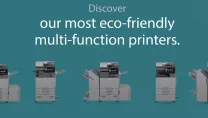The last 12 months have been a difficult time for business. From the outbreak of the Russia/Ukrainian war putting incredible pressures on inflation, to the continued aftereffects of the global pandemic, all stages of the value chain, not only in Europe but around the world, are starting to acutely feel the pressures of an economic downturn.
Regardless of the pressures facing organisations, we still need to face ongoing challenges within our industry. In the first part of our print predictions and trends 2023, we looked at how connected devices are helping evolve hybrid working, strategies, as well as the steps being taken towards an ever-more secure infrastructure. This time, we explore how automation is helping change the way the print industry operates, while at the same time why sustainability must remain a key business concern, as we cannot afford to let future generations down.
Sustainability is reshaping print priorities in the smart office
Over the last decade we have seen the discussion and the need for action around sustainability and the green agenda rise to the top of corporate concerns. We are all aware there is no quick win, and even with the touch economic climate all businesses are facing, we must invest for the future, otherwise there simply won’t be a future.
There continues to be a wide range of initiatives that continue to advance and refine sustainability measures. For print, the European regulators are continuing to introduce new regulations, either in draft form, so manufacturers have sight of what to expect, or are now actually being implemented, and becoming law.
Another great example is the ‘Right to Repair’ movement, which continues to gather pace in Europe. Initially driven by the dissatisfaction of consumers around the lack of practical means with which to repair devices, it is forcing manufacturers to look at their design and build processes.
The EU has created several regulations around making it easier for customers to repair product themselves through the availability of spare parts and instruction manuals. It’s a trend that started in the consumer space, but it is moving into the B2B market and is something we need to be prepared for.
Printers and MFPs will ultimately fall into that category, for example. Therefore, we will as an industry have to comply to similar regulations. This will have a direct sustainability impact because it extends the life of those products. Sharp is already looking into what we need to be doing to provide our customers the right to repair.
When we look to design new products, energy efficiency is a top priority. Therefore, all our devices comply with Energy Star 3.0, which simply reduces the amount of energy devices consume both when they're being used, and when they're in their various standby modes.
Then there is the circular economy, which is helping us to reduce our reliance on virgin materials. Our latest generation of A3 devices are a great example of this, we've increased the use of recycled materials in the manufacturer of these products. They come with a robustly sustainable design offering up to 27% more energy saving compared with previous generations, smart diagnostics and minimised waste.
It is not just the device itself, as we continue to also make consumables more efficient. We have introduced new toner, for example, which has a lower melting point, requiring less energy to fuse the toner onto the paper. We’re also minimising wastage by making sure the toner cartridge keeps printing until its empty and only then auto-ejecting. This reduces the risk of users replacing the cartridges before they're fully depleted.
We've put in longer life components, which means that the devices last for longer and require less service interventions. This has the knock-on effect of reducing the number of times an engineer must come out to service or repair products, lowering impact on the environment.
Refining workplace efficiency through the automation of processes
One trend we will continue to see grow in the coming years is the automation of processes to streamline workplace efficiency. The removal of manual steps from routine operations speeds up productivity, while at the same time reduces overall costs.
The COVID-19 pandemic forced many businesses to look at their processes and automate them to allow for remote and hybrid working. It’s no surprise that this came at the expense of paper, which has long been an important part of manual business processes.
The latest economic pressures will force those who didn’t fully adopt the automation of processes to re-access their position. Meanwhile those who did automate, will look for other opportunities to automate to help reduce costs.
Printers still have a role to play in the automation of many business as often there is content that is in analogue form that needs to be added to digital workflow processes. That is where the scanning and OCR capabilities of print devices become important – acting as an interface between analogue format and cloud connectors that take that data and push that into workflows. As a result, businesses need to continue to embrace print and position it as a tool that augments digitisation.





